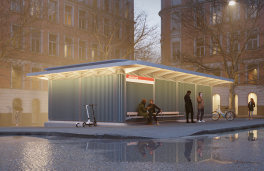 Project
Project
Energy islands with minimal environmental impact
01.09.2021Our architects and landscape architects have aided water construction experts from DHI A/S in developing a concept for the construction of energy islands with the smallest possible negative impact on the surrounding marine environment.
Based on parallel development of construction methods and design as well as interdisciplinary collaboration, Gottlieb Paludan Architects and DHI A/S have designed an island that is built mainly of sand, which is typically found in large quantities on the seabed. In addition to sand, the proposal uses groynes as coastal protection which makes it possible to design an island that is part of the natural marine environment with beaches, dunes and underwater rock reefs that provide new habitats for flora and fauna.
By mimicking nature and using raw materials already available on site, the transportation and processing of materials is minimized. This is also an end-of-life benefit where the island could be reused for other purposes or disposed of with minimal impact on the natural marine environment.
The development project is based on a unique approach that perceives marine forces, such as waves and tides, as external opportunities that can be used to maintain artificial beaches - in contrast to the traditional approach, where the marine environment is considered a problem generator. In other words; we work with nature, not against it.
The approach, which is also called 'soft engineering', "reduces negative impact on the environment and creates more sustainable solutions as compared to hard engineering projects, such as building sea walls, groynes and other structures", says Dr. Nicholas Grunnet, Head of Coastal and Estuarine Dynamics at DHI.
The proposal is an example of something we are particularly good at in Denmark, and that the world around us is looking for: Uniting industrial infrastructure, landscape and architecture through integrated visionary design and interdisciplinary thinking. GPA and DHI are further developing the concept for marine environments around the world.
Read more about the project here.










